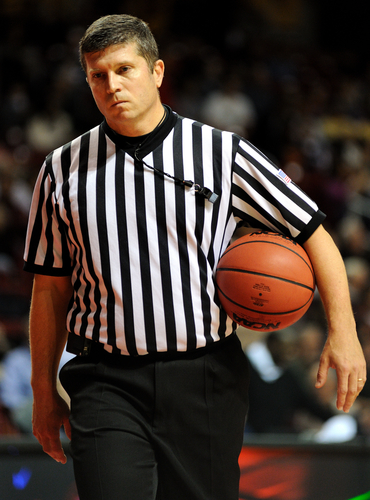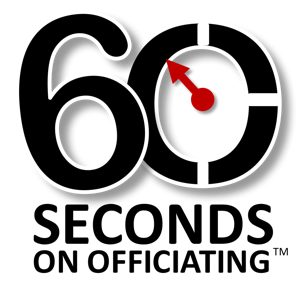
5 Things the Rulebook Says You Should Be Doing
… And you might not even be aware of.
As you progress in your officiating career you most likely will settle in to a level of comfort in rules knowledge and mechanics. While this is a good thing sometimes we overlook nuances that are outlined in our prescribed duties as a referee or crew official.
Here are a few items found in our scholastic (NFHS) manual that may be already part of your routine … or these could represent areas that are unknown and would make a fine new addition to your officiating repertoire for 2015.
- The (assigned) REFEREE for the game shall DESIGNATE the OFFICIAL to TOSS the ball in the center restraining circle for all jump ball situations. That’s right. If you’re the crew chief and not a great tosser – this gives you a great option to assign this task to a partner. Also this is a nice way to allow less tenured officials an opportunity to experience the thrill of tossing under your observation. Remember – the table-side U1 (in both 2 and 3 person crews) can blow their whistle and request a re-toss if necessary.
- The (assigned) REFEREE shall also be responsible for having EACH TEAM NOTIFIED 3 MINUTES PRIOR TO the start of EACH HALF. If the teams are on the court and ready to go this becomes a moot point. But if either team is in the locker room and it’s approaching 3 minutes – you should think about how to get a message to the teams. This is not a “courtesy” but rather a specific duty outlined in the rule book. Leverage your on site administrators, team assistants, bench personnel, scorers, timers, etc … or even an officiating crew member that is responsible for observing that team during warm-up. If the teams fail to appear and they consume a full minute through not being ready to play when it’s time to start the 2nd half – a Team Technical foul would be warranted. The resumption of play procedure (placing the ball on the floor to avoid a technical foul) should only be used after time-outs and after the intermission between quarters.
- If the officiating crew cannot agree on whether a GOAL should be COUNTED the (assigned) REFEREE shall make that DETERMINATION. Information can be gathered from not only the crew but also the official timer and scorer – but the ultimate decision, if your partners cannot agree, rests upon the REFEREE’s shoulders. It’s always best as the Referee to take in all the elements of the play or situation before making a unilateral decision. But you do hold the power if needed.
- On the topic of notifications – one of the officiating crew’s general duties is to NOTIFY THE CAPTAINS when PLAY is about to BEGIN at the START of the GAME. The easiest mechanic is for the tossing official to sound their whistle once the players are ready and set prior to the jump ball. Remind the teams (and your crew) of the team’s basket choice as a double check insuring teams are facing the proper direction. Right after this look at the visiting captain and say something like ” Blue Captain #21 are you ready?” Then repeat this for the home team – “White Captain #5 are you also ready?” While the notification does not have to be in the form of a question — it’s a respectful gesture to give them a moment to respond and starts the professional bond between you and the speaking team captain for each squad.
- A common responsibility that (arguably) is missed by many experienced officials relates to the foul calling sequence. When a foul occurs the official shall SIGNAL the TIMER to STOP THE CLOCK with a closed fist. That’s the easy one we all get. The part many of us forget is the requirement to VERBALLY INFORM the OFFENDER. This should all occur near the spot of the foul after stopping the clock properly. What we see (much of the time) is the stop clock signal followed by the calling official moving toward the table to report the foul to the scorer. While this is appropriate for the final piece of the foul calling sequence – there should be a communication to the offender at the spot BEFORE you go to the reporting areas. Indicating the COLOR and NUMBER of the offender along with the appropriate preliminary signal will not only satisfy this requirement but alerts your crew to your ruling and embeds in your mind the proper player this foul should be assessed to.
These five represent a few of the more “obscure” responsibilities of the officiating crew. If you have any of your own to share feel free to comment below.
NFHS Rules Reference
2-4-4, 2-5-1, 2-5-3, 2-7-1, 2-9-1

At the point, during a requested and granted team timeout, when the warning horn has sounded (after 15 seconds have elapsed during a 30 second timeout or 45 second have elapsed during a full 60 second timeout), the two officials standing at their designated spots MUST go to their respective team huddles and give the indication that “the first horn has sounded.” This is not an optional thing; it MUST be done.
And once there, after having given that indication (as a general gesture); if you see no immediate response, you might attempt to get a specific individual’s attention (assitant coach, other team member, etc. – not necessarily the head coach) and speak directly to him/her concerning this “first indicator” event. It creates a sense of repoire’ with that team as well as the use of preventative officiating.
Great commentary Doug. I would even add to this … As the official that is providing the indication to the huddle, I would (as you suggest) stay there until you see general movement back on toward the court.
If the team is slow to respond and the 2nd (final) warning horn has sounded, I will give a 2nd indicator whistle and say something like … “that is the 2nd and final horn, we are going to put the ball down and play …” or something to that effect.
In our pregame I would have discussed this scenario of when to invoke the “resumption of play” procedure and put the ball on the floor. I suggest your partner not put the ball down until the entire crew is in position and all preventative officiating has been done.
Just good karma and then they can’t say … “you didn’t warn me!”
Just one quick thought with respect to uniforms and something to think about as the fashion police with regard to Rule 3-5 Art 6… As a crew we are watching the teams warm up & we’re looking for compliant colors on the compression gear, headbands, wristbands….. Looking good, right? The horn sounds at the one minute mark, the teams go the benches, the players pull off their “shooting” / warm-up shirts, the coach gives his final talk, & the starters are announced……… Lo, and behold, one of the visiting starters in an orange jersey gets announced & he’s wearing a black T-shirt under that orange jersey…. Ouch. Now we gotta deal with that at that point. Just one more thing we can cover early. Maybe remind the captains at the pregame and the coaches when you greet them. The player simply cannot play with that T-shirt on by rule.
If I’m not mistaken, the resumption of play procedure does not apply prior to the start of each half. If either team is not on the floor ready to play, a technical foul is assessed if the start of the half is delayed by a full minute. 10-1-5a
Thanks Bill … great clarification to this article. I will add some clarity to this.
Pertaining to Rule 10-1-5a, this usually applies when a team refuses to come out of their locker room to begin the 2nd half (3rd quarter) for various reasons. The most recent time I was aware that this actually occurred was when a team believed it didn’t have a chance to win the game (thinking that the lop-sided halftime score was insurrmountable, the game officials were biased toward their opponent, etc.).
The “resumption-of-play-procedure,” as detailed in Rule 7-5-1a, b, c and d, specifies that it shall be “used to prevent delay when a team does not make a thrower available, after a time-out OR THE INTERMISSION BETWEEN ANY QUARTER (as in 6-2-3). The administering official will sound the whistle to indicate play will resume. In each situation: a. the ball shall be put in play if Team A is ready OR it shall be placed on the floor.” And, then, so on through items b, c and d.
Great stuff as always. Thanks.
Is there really any reason to know who the floor captain is? Does anybody really use it, at least at the HS level? I know that for my state, lots of people ask who the floor captain is but probably can’t remember who it is ten seconds later nor does it have even the slightest impact on the game.
I agree with you 100%. I think it’s just an older tradition that may have had more relevance in seasons past. Truthfully, I rarely (if ever) remember (or even think about) who the captains are after the pregame coach/captains meeting. Any player can talk to me (respectfully) or ask questions at any time during the game so I don’t really see the significance of having designated players as spokespersons; seems like more of a honorary/symbolic thing to me.
you are just reminder the team captain to get his or her players if they are losing control so it stop us from giving that text.